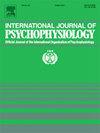The impact of reducing cognitive load in RT and P300 concealed information tests with importance related fillers
IF 2.5
3区 心理学
Q3 NEUROSCIENCES
引用次数: 0
Abstract
Lukács et al. (2017) enhanced the Reaction Time Concealed Information Test (RT CIT) by incorporating “filler” items. Fillers are intended to increase attention and cognitive load, which should potentially enhance the P300 based CIT (P300-CIT) too. Despite these hypotheses, Olson et al. (2020) found no clear effects of fillers on P300 amplitude and suggested that excessive cognitive load may counteract an increase in attention. Wojciechowski and Lukács (2022) introduced “importance-related” fillers to the RT-CIT in an imaginary mock crime scenario, theorizing they would be more intuitive and easier for participants to follow. This study aims to replicate their findings in a classic episodic mock crime scenario, and with semantic information, to test if a fillers-related enhancement effect on P300 may be observed when cognitive load is reduced. The study compares three protocols: the importance-themed enhanced CIT (E-CIT), a less cognitively demanding version of the E-CIT, the inducer CIT (I-CIT), and the classic three-stimulus protocol (3SP-CIT). The study investigates whether the I-CIT yields a superior P300-CIT effect due to reduced cognitive load and induced semantic context of importance. Reaction time analyses replicated the RT-CIT effect enhancement in the E-CIT compared to the classic 3SP-CIT. Elevated response times in the E-CIT compared to the 3SP-CIT and I-CIT suggest higher cognitive load in the E-CIT. Response times were comparable between the 3SP-CIT and I-CIT, suggesting similar cognitive load. For the P300-CIT results, similar to Olson et al. (2020), fillers did not affect P300 amplitude or latency in the E-CIT group, with Bayes factors supporting the null. Contrary to expectations, no clear enhancement of P300 was observed in the I-CIT, suggesting that cognitive load imposed by fillers does not counteract P300 amplitude.
重要性相关填充物对降低RT和P300隐藏信息测验认知负荷的影响。
Lukács 等人(2017 年)通过加入 "填充 "项目增强了反应时间隐藏信息测试(RT CIT)。填充项目旨在增加注意力和认知负荷,因此也有可能增强基于 P300 的 CIT(P300-CIT)。尽管有这些假设,Olson 等人(2020 年)发现填充物对 P300 振幅没有明显影响,并认为过度的认知负荷可能会抵消注意力的增加。Wojciechowski 和 Lukács(2022 年)在一个假想的模拟犯罪场景中为 RT-CIT 引入了 "与重要性相关 "的填充物,他们认为这些填充物会更直观,更容易被参与者接受。本研究的目的是在经典的情节性模拟犯罪场景中,利用语义信息复制他们的研究结果,以检验当认知负荷降低时,是否可以观察到与填充物相关的 P300 增强效应。研究比较了三种方案:以重要性为主题的增强型 CIT(E-CIT)、认知要求较低的 E-CIT 版本、诱导型 CIT(I-CIT)和经典的三刺激方案(3SP-CIT)。本研究探讨了 I-CIT 是否会因认知负荷的降低和诱导语义背景的重要性而产生更好的 P300-CIT 效果。与经典的 3SP-CIT 相比,反应时间分析复制了 E-CIT 的 RT-CIT 效果增强。与 3SP-CIT 和 I-CIT 相比,E-CIT 的反应时间更长,这表明 E-CIT 的认知负荷更大。3SP-CIT 和 I-CIT 的反应时间相当,表明认知负荷相似。在 P300-CIT 结果方面,与 Olson 等人(2020 年)的研究结果类似,填充物并没有影响 E-CIT 组的 P300 振幅或潜伏期,贝叶斯因子支持无效。与预期相反,在 I-CIT 中没有观察到 P300 的明显增强,这表明填充物造成的认知负荷不会抵消 P300 的振幅。
本文章由计算机程序翻译,如有差异,请以英文原文为准。
求助全文
约1分钟内获得全文
求助全文
来源期刊
CiteScore
5.40
自引率
10.00%
发文量
177
审稿时长
3-8 weeks
期刊介绍:
The International Journal of Psychophysiology is the official journal of the International Organization of Psychophysiology, and provides a respected forum for the publication of high quality original contributions on all aspects of psychophysiology. The journal is interdisciplinary and aims to integrate the neurosciences and behavioral sciences. Empirical, theoretical, and review articles are encouraged in the following areas:
• Cerebral psychophysiology: including functional brain mapping and neuroimaging with Event-Related Potentials (ERPs), Positron Emission Tomography (PET), Functional Magnetic Resonance Imaging (fMRI) and Electroencephalographic studies.
• Autonomic functions: including bilateral electrodermal activity, pupillometry and blood volume changes.
• Cardiovascular Psychophysiology:including studies of blood pressure, cardiac functioning and respiration.
• Somatic psychophysiology: including muscle activity, eye movements and eye blinks.

 求助内容:
求助内容: 应助结果提醒方式:
应助结果提醒方式:


